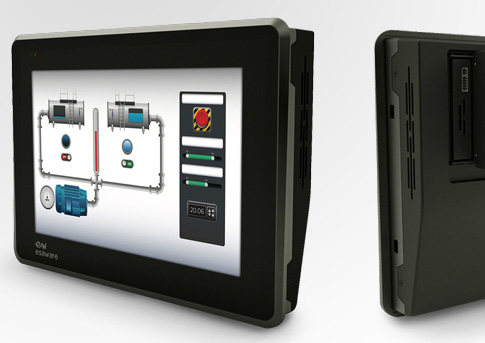Today it’s very important to know what is HMI. Human-Machine Interface is one of the hottest topics in Industrial Automation. In fact, it would appear that the future of this field lies right in the hands of this technology.
Therefore,it’s not surprising that a fierce competition was born between companies in order to come out with the most innovative platform, which will be able to bring closer two worlds eventually destined to merge: humans and machines.
What Is an HMI system?
It’s time for some clarification about what we are talking about. Exactly, what is a HMI?
A HMI, aka Human-Machine Interface, is a device or software that allows its user to communicate with machineries and production plants. How? By translating a huge amount of complex data into accessible information. In this way the operator has all the necessary tools to control the production process.
Contextualizing this definition in the world of Industrial Automation, it’s clear how the more responsive and user-friendly the HMI, the more efficient and cost-effective the job.
HMI evolution
In order to truly understand what is a HMI, we must take a step back. Actually, we have to start form zero and see how this technology has evolved.
It all started with a button. And then there was light. With light came the switches. Then hardwired devices appeared, which became electronic panels. Eventually, it came the time of personal computers and software programs, which thrivedand conquered the scene.
And so,within a few years, the world of Human-Machine Interfaces has gone through a massive evolution. However, experts have no doubts about it: we have not seen but the tip of the iceberg.
But what does make these systems potentially limitless? There are two answers. First, it’s all about the software. Today we are witnessing a progressive standardization of what before was considered an optional (i.e. touch screen or color display) and companies have to compete in terms of programs and SCADA.
Second, integration with the new “physical” technologies. Those trends that mark common-use technological devices. This is the last generation HMIs’ trend: enabling people that use them to find the same familiar and easy usage of smartphones and tablets.
HMI in Industrial Automation
Finally, we got to the most interesting part for those who work in this sector. What is HMI’s relation with Industrial Automation?
Basically, a HMI device enables visualization and control of applications. By using resources such as I/O, SoftPlc CoDeSys or Ethercat, and operating systems (even better if embedded), it allows you to communicate with any production system.
Depending on the plant, the device’s features can change, in terms of connectivity, technology and even dimensions. Therefore, in Industrial Automation we can find HMIs that vary from standard 4.3 inches devices to sophisticated wide screen 15.6 inches displays. That’s why anyone can find the right solution.
In order to simplify even more the operators’ job, the touch screen technology (capacitive or resistive) is available, allowing an intuitive interaction with machines and production plants.
Now you know what is an HMI and what its role in Industrial Automation is. Share this article and keep following us in order to be always updated about all latest developments in human-machine interface.

